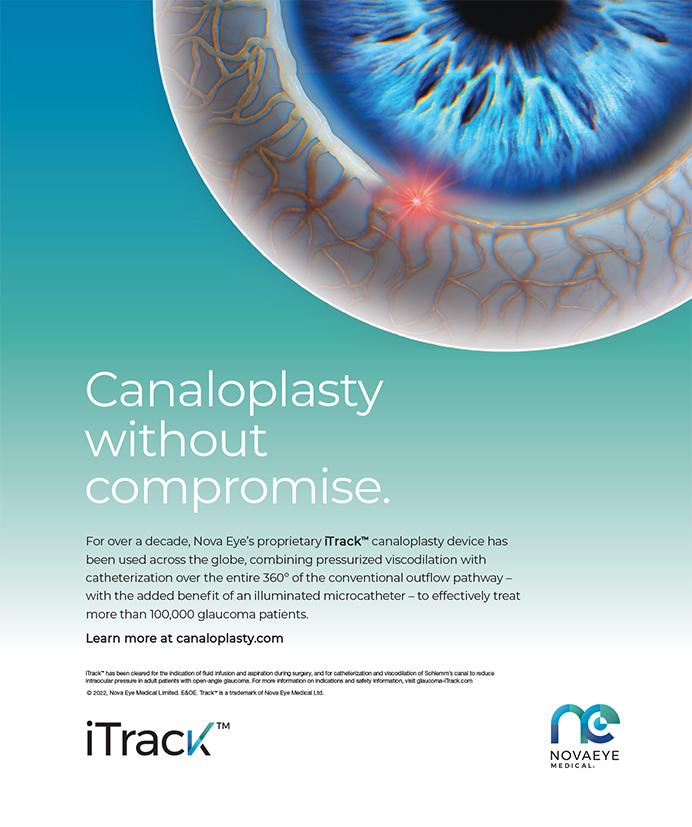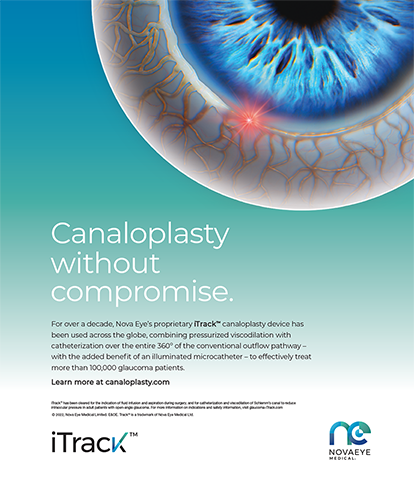Language often evolves in spite rather than because of logic. Applying the term bimanual to phacoemulsification grew naturally out of its appropriate use in describing I/A. For better or worse, ophthalmologists will probably continue using the term bimanual microincisional phacoemulsification. Unfortunately, it does not truly reflect the essential features of the technique.
Takayuki Akahoshi, MD, of Tokyo recently reported on coaxial cataract extraction and IOL insertion through a
2-mm incision.2 He described using a flared phaco tip and a small-diameter sleeve for prechopping and extracting the cataract. He then introduced a single-piece Acrysof IOL (Alcon Laboratories, Inc., Fort Worth, TX) through the unenlarged incision by placing the insertion cartridge's tip just at the edge of the incision and pushing the IOL through with the plunger. He billed this method the sayonara technique, because he asserts that it will allow surgeons to say, “Sayonara, bimanual.” His underlying assumption that bimanual microincisional phacoemulsification is only about the incision's size demonstrates a superficial understanding of the technique. This problem relates directly to the unfortunate nomenclature that Dr. Arshinoff criticized. Actually, bimanual microincisional phacoemulsification uniquely enhances surgical control as well as the safety of refractive lens exchange.
INFLOW AND OUTFLOW
A smaller-sized incision is one of many advantages that make bimanual microincisional phacoemulsification a superior technique to coaxial phacoemulsification. A crucial difference, however, is the separation of inflow and outflow. We believe that the benefits of this fluidic paradigm shift include greater flexibility, improved surgical control, and better outcomes. At the same time, we recognize the significant role that the introduction of micropulsed ultrasound energy (Whitestar technology; Advanced Medical Optics, Inc., Santa Ana, CA) has played in setting the stage for bare-needle phacoemulsification. The use of extremely short pulses of ultrasound energy, with a variable duty cycle, initially allowed safe bimanual microincisional phacoemulsification by removing the risk of thermal injury to the cornea.
Separating the irrigation from the aspirating phaco needle improves the followability of nuclear fragments by eliminating competing currents at the tip of the needle. In some instances, the ophthalmologist may use the irrigation flowing from the second handpiece as an adjunctive surgical device (eg, to flush nuclear pieces from the angle or to loosen epinuclear or cortical material from the capsular bag). In refractive lens exchange, the surgeon may wash lenticular material completely out of the bag and extract it with aspiration and vacuum only. The procedure is thus safer, because no ultrasound is necessary and no instrument enters the endocapsular space during this phase. The flow of fluid from the open end of an irrigator represents a gentle instrument that can mobilize material without traumatizing delicate intraocular structures.
Another benefit of a separate infusion stream is evident during posterior capsular polishing (Figure 1). Focusing the flow of fluid on the posterior capsule and stretching the tissue facilitates capsular polishing with either a rough or silicone-covered aspiration tip. The taut posterior capsule shows less inclination to become entrapped in the aspiration port, and the surgeon can more easily strip away subcapsular plaque.
VERSATILITY
Perhaps the greatest advantage of the bimanual technique is it allows the surgeon to remove subincisional cortex without difficulty. As originally described by Brauweiler,3 by switching the I/A handpieces between two microincisions, the ophthalmologist can easily reach 360° of the capsular fornices and perform cortical cleanup quickly and safely (Figures 2 and 3). The ability to switch hands also represents a significant advantage to instructors of phacoemulsification, who may have to take over a case from a resident with opposite manual dominance.4
COMPLICATIONS MANAGEMENT
Bimanual microincisional phacoemulsification also provides significant advantages in complications management. If surgery compromises the posterior capsule, the first goal of the surgeon is to maintain the anterior chamber's stability to prevent both the posterior migration of lenticular material and an anterior prolapse of the vitreous. By maintaining infusion high in the anterior chamber, the ophthalmologist can more safely reach posteriorly with the phaco needle, aspiration tip, or vitrector to remove residual lenticular tissue. One need never bring irrigation down into the capsule where it may dislodge lenticular tissue, enlarge the capsular tear, or engage the vitreous. Keeping the flow of irrigation constant avoids hypotony, much like an anterior chamber maintainer.5 After evacuating all lenticular material from the eye, the surgeon may inject viscoelastic prior to removing the irrigator so that the vitreous face remains under tamponade.
OUR EXPERIENCE
We have found bimanual microincisional phacoemulsification to be enormously advantageous for refractive lens exchange and routine cataract surgery, because it maintains an exceptionally stable intraocular environment during lens removal. This stability may be especially important in high myopes, who are at high risk for retinal detachment following lens extraction.6 Maintaining a formed and pressurized anterior chamber throughout the procedure should decrease anterior movement of the vitreous body and, theoretically, result in a lower incidence of posterior vitreous detachment due to intraoperative manipulations. Future studies are needed to document any reduction in posterior-segment morbidity owing to this method of lens removal.
Of course, some of bimanual microincisional phacoemulsification's major advantages do relate to the incision's size. For example, we have found that thus increasing the chamber's stability improves surgical control. Moreover, because viscoelastics do not leave the eye easily through small incisions, the anterior chamber is more stable as we construct the capsulorhexis, and the development of an errant capsulorhexis is far less likely. A stable chamber can also provide important surgical control of the capsulorhexis during refractive lens exchange in a case of high myopia with an extremely deep anterior chamber and floppy capsule. In addition, we are able to perform hydrodelineation and hydrodissection more efficiently by virtue of a high level of pressure in the anterior chamber prior to the eventual prolapse of viscoelastic through the microincisions.
Finally, surgeons' adoption of microincisional techniques has motivated manufacturers to develop delicate, exquisite forceps for the construction of the capsulorhexis. The result has been unparalleled surgical control.
CONCLUSION
We have found bimanual microincisional phacoemulsification to be simple, efficacious, and safe; the extraction of most of the lens occurs in the plane of the iris, away from the posterior capsule and the corneal endothelium. Whether surgeons employ 18- or 21-gauge incisions, the principal advantages of this technique are due to the separation of infusion and aspiration. No matter how small the incision is, coaxial techniques cannot achieve these benefits.
I. Howard Fine, MD, is Clinical Professor of Ophthalmology at the Casey Eye Institute, Oregon Health & Science University, and he is in private practice at Drs. Fine, Hoffman, & Packer in Eugene, Oregon. He is a consultant to Advanced Medical Optics, Inc. Dr. Fine may be reached at (541) 687-2110; hfine@finemd.com.
Richard S. Hoffman, MD, is Clinical Associate Professor of Ophthalmology at the Casey Eye Institute, Oregon Health & Science University, and he is in private practice at Drs. Fine, Hoffman, & Packer in Eugene, Oregon. He states that he holds no financial interest in the products or companies mentioned herein. Dr. Hoffman may be reached at (541) 687-2110; rshoffman@finemd.com.
Mark Packer, MD, FACS, is Clinical Assistant Professor of Ophthalmology at the Casey Eye Institute, Oregon Health & Science University, and he is in private practice at Drs. Fine, Hoffman, & Packer in Eugene, Oregon. He is a consultant to Advanced Medical Optics, Inc. Dr. Packer may be reached at (541) 687-2110; mpacker@finemd.com.
1. Arshinoff SA. Biaxial phacoemulsification. J Cataract Refract Surg. 2005;31:646.
2. Technique allows IOL insertion through sub-2-mm incision after coaxial phaco. Ocular Surgery News. June 3, 2005. Available at: http://www.osnsupersite.com. Accessed October 21, 2005.
3. Brauweiler P. Bimanual irrigation/aspiration. J Cataract Refract Surg. 1996;22:1013-1016.
4. Smith JH. Teaching bimanual microincision cataract surgery in a residency program. Paper presented at: The ASCRS/ASOA Symposium on Cataract, IOL and Refractive Surgery; April 19, 2005; Washington, DC.
5. Blumenthal M. Use and results using the new ACM. Paper presented at: The ASCRS/ASOA Symposium on Cataract, IOL and Refractive Surgery; April 18, 2005; Washington, DC.
6. Colin J, Robinet A, Cochener B. Retinal detachment after clear lens extraction for high myopia: seven-year follow-up. Ophthalmology. 1999;106:2281-2284.


